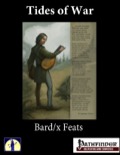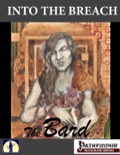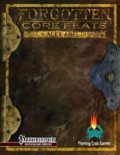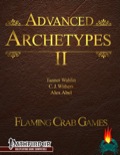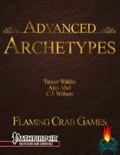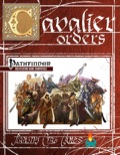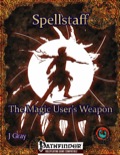Sign in to create or edit a product review. Tides of War: Kineticist/X Feats is a short supplement containing feats for multiclass kineticists. Much like the similar product I reviewed earlier (Bard/X Feats), it contains a page and a half of feats, all designed to be taken as early as character level 3rd. None are a simple “Count your level as X for the purposes of Y” – rather, they all add new ways to use a kineticist, in particular, the burn mechanic. Many of the feats require you to accept burn to utilize them, with a note in the introduction of the product stating that the burn cost cannot be reduced by any means, including gather power. Examples include the ability to reduce the bonus to Constitution granted by a mutagen instead of accepting burn, add a hex to a kinetic blast, add the advanced template to summons, or funnel burn into one of many ‘pool’ class features to restore points to them. My personal favourite may be Raging Kinesis, which allows a raging character to form their kinetic blade as a free action and keep it activated for the duration of their rage! Generally, the kineticist class doesn’t lend itself to multiclassing, but these feats provide new and interesting ways to do so. Pick it up if you’re interested in expanding your kineticist, or playing in a gestalt campaign – it’s cheap and worth it. Disclaimer: I received a free copy of this product in exchange for an honest review. Tides of War: Bard/X Feats is designed for multiclass bards, with most feats designed to be taken as early as 3rd level. It contains two pages of content after stripping out credits, cover, OGL, and introduction. They’re simple and straightforward, allowing combat bards easier access to Extra Performance and masterpieces, scholarly bards to stack class levels for Bardic Knowledge, and all caster bards to prepare bard spells as other class cantrips. Want to grant sneak attack to allies, boost performances while smiting enemies, or use percussive fists to increase your performance output? Does your bard have occult implements, a pet, or a favoured enemy? The last two talents allow extra uses of a talent, or – saving the best for last – allow a bard with the Order class feature to Bluff his way out of any consequences for violating the edicts of his order. None of the feats particularly blew me away, but all are solid and work exactly as you’d expect. Fun options for multiclass bards at a low price makes me feel comfortable giving this 5 stars. Pick it up if you’re a fan of fun multiclass options. Dislcaimer: I received a free PDF of this product in exchange for an honest review. I am otherwise unaffiliated with Flying Pincushion Games. As a music fan, I was excited to start playing bards in Pathfinder. The 3.5 class never felt satisfying, and Paizo really made the class interesting and appealing again. Since then, I’ve eagerly devoured every bard archetype and masterpiece I’ve come across, and while it’s taken me a while to write this (life happens, games start, summer hits), I finally sat down to write out the thoughts I had about this product. I’ll be honest here, folks: I love it. Almost every archetype is mechanically solid and thematically inspiring. The first piece of content in the book, the Chronicler of Blades archetype, is the weakest point for me – available only to elves, it swaps out all spellcasting for bonus combat feats from a restricted list, allows full BAB to be used for swords for which the bard has Weapon Focus, replaces versatile performance with a +4 bonus on skill checks to learn or remember the features of swords, and replaces Versatile Performance with the ability to add half the result of a Knowledge check to an attack roll or combat maneuver check a limited number of times per day. It strips all versatility from the class, and plays into the hackneyed trope of elves being, like, just the best at swordplay, you know? Thankfully, once the product moves past this weak point, everything is far more interesting. The Courtless Marvel, dancing on the edge of the fey courts, can mimic summon nature’s ally (scaling with level) with his performance, grant allies the speed of quicklings, and mimic the stunning glance of a nymph. He gains wild empathy, druid or ranger spells as spells known, and an expanded summon nature’s ally list. The Fabulist changes his casting stat to Wisdom, chooses an archetypal animal and can form a bond with it as a familiar (just don’t choose the wolf as your animal, because you get nothing in exchange), and learns spells from a domain, automatically gaining them instead of choosing his first spell known of each level. (Note: the four alignment domains are available, but without the expected caveat about the character’s alignment matching.) He can allow allies to use his own Wisdom bonus on Will saves, call extraplanar allies using a limited planar ally, and offer atonement to people with his fables. The Grotesque was the first archetype that not only intrigued me but really won me over for sheer cool factor. Based on the idea of carnival “freaks and geeks”, he is less knowledgeable overall than the vanilla bard, having fewer spells known (but not spells per day), no lore master, and no bardic knowledge. Instead of inspiring his allies, he disturbs his foes, through a modified “reversed” inspire courage, two new performances that can sicken and nauseate (without replacing any other performances, it should be noted), and his unique Disturbing Acts – sideshow performances that grant him a bite attack, use his extensive body modifications to distract foes, vomit the contents of his stomach, or cover himself in swarms of vermin that attack indiscriminately. While this archetype is hilarious and awesome, it needs clarification – do disturbing acts count as bardic performances? Some allow him to start a performance as part of a special action linked to the act, others don’t, and one seems to imply that it is its own performance. The product would benefit from this clarification. The Jester gains Antagonize for free and adds half his level to select Perform skills, as well as the ability to substitute them for social skills. Giving up spellcasting for evasion, improved evasion, and half-progression sneak attack, he plays very differently to your average performer. Thankfully, he can cause foes to become flat-footed by hurling japes at them, ensuring he’ll have plenty of chances to deal that sneak attack. Next, the Lifeweaver is a healer bard, adding restorative and raising spells to his spell list (not spells known), granting allies fast healing (capping out at fast healing 6), dividing all damage and healing received between bonded creatures, granting energy resistance and DR/-, and gaining the ability to channel energy. It’s a simple but neat archetype. I’ll be honest about the Matchmaker: I don’t know what to do with it. While the increased save DCs on emotion spells and the (Ex) charm person-esque Serenade ability are cool, the archetype seems for NPCs only. I’m not against the idea, but I’m not sure how I can use this (as a player or a GM). The Prop Comic is an entirely different matter – a master of slapstick performance. Ever wanted to force an enemy’s allies to move away from them, provoking attacks of opportunity? Stick an exploding cigar in someone’s mouth? Deal damage to swarms with a comically-oversized mallet? Convince an injured foe to open what looks like a healing potion, but actually contains a snake swarm? Two bonus feats (Catch Off-Guard and Throw Anything) and a scaling bonus to attack and damage rolls on improvised weapons are icing on the cake. This archetype had me literally laughing as I read it! The Rookery Master replaces bardic knowledge, well-versed, loremaster, and two versatile performances to gain a total of four bird familiars, which can (one at a time) share his bardic performances. He can always speak with birds, use feathers from these familiars to craft magic items, and (my favourite) use augury by interpreting the flights of birds. The Skirling Adept focuses on the oft-ignored totem spear, allowing him to deal large amounts of sonic damage to enemies, deafening and dazing them, gaining a unique familiar, and gaining the ability to use call lightning and wind wall at higher levels. The Song Bow is proficient with all bows and slings and treats them as musical instruments, using whistling arrows and groaning bullets as the designated originators of his performances. He can deal extra sonic damage with his shots, grant bonus damage to allies, and knock enemies prone with the sonic force of his arrows, even gaining the ability to create earthquakes at high levels. The last archetype is the exhaustive Squad Leader, who gains Urgent Commands instead of bardic performance. These commands include Move Out (allies can immediately move a short distance), Hunker Down (gain bonuses to AC), Suck It Up and Get Over It (make an additional save against some conditions), and the delightfully-named Do I Have to Do Everything Myself? (gain the Solo Tactics class feature). While that’s it for archetypes, the product contains many more class options: next is the Holy Rhapsodist, a 5-level prestige class for paladin/bards. It gets 4 + Int skills per level, good Fortitude and Reflex saves, and four levels of spellcasting. They can turn their untyped damage from smite evil into sonic damage, heal a number of allies by expending Lay on Hands (which seems to work out to be less healing than channelling energy, oddly), apply mercies by expending rounds of performance, grant fear immunity to allies, cause her bonus damage from smite to strike an opponent at range for as long as a performance persist (awesome!), cast searing light, summon choral angels, and grant extra damage to allies striking the target of her smite. While it’s a decent and evocative prestige class, I’m underwhelmed by the Psalm of Healing class feature – allies up to your charisma modifier, for half the healing of a lay on hands, is worse than affecting all of them for the full amount, for the exact same cost. The only way I can see this edging out is if you didn’t take selective channel. The Mime, an alternate class for the bard, is an interesting beast. Limited to humanoids and native outsiders, he gains no proficiencies, and the ability to cast arcane spells, but only by using performance rounds to mimic what he sees other creatures doing. This is the mime in a nutshell: he has no unique class features, but can mimic his allies to become a hyper-versatile member of a large party. His copycat performance allows him to duplicate the actions of allies – if a fighter ally attacks an enemy with a +1 flaming longsword, the mime can also attack that ally with an invisible +1 flaming longsword, using his own modifiers. He also gains the Mimic class feature, which he can use to conjure his own copies of other people’s armor, emulate class features such as bombs or sneak attack, gain the use of feats, or copy the effects of wands and potions. The mime seems to be at his best when part of a large party, and near-useless in a small one. Still, it’s certainly fun, and I’d like to be able to try one out with a permissive GM. Next are the rules for fairy plays, single-use magic items that require the performance of a short and whimsical play to activate. The rules for creating your own are included alongside three examples – my personal favourite is “The Haunted Dooryard”, which grows and animates spooky, glowing pumpkins! Finishing off the product are 6 new wondrous items, each of which functions as a masterwork instrument for a different Perform skill. For example, the mask of cowardly courage renders a performing wearer immune to fear, “as long as he incorporates theatrical, buffoonish cowardice into the performance”! And my favourite of the items, the Hell’s hurdy-gurdy, can cause devils to summon their allies, before engaging in randomized acts of debauchery (a handy d% table is provided). In short, this is a very fun product with some very cool options, plenty of solid ones, and a few underwhelming ones. I’d appreciate it further if there was a consistent two-column layout throughout – the class options all follow two-columns, but the rules for fairy plays and the new magic items are single-column, which isn’t as friendly on the eyes. This is, ultimately, a minor quibble, and won’t subtract from my final verdict of a healthy four stars. Great job, pincushions! $2 Generals: Deiro Domine earns points for being a cool concept; prepackage a powerful NPC that can be dropped into any game quickly and effectively, or woven in from the beginning. However, the actual construction of the product leaves much to be desired. Deiro's statblock is confusing in a lot of ways, ranging from an unclear indication of how he was built to numerous formatting issues such as spells not being presented in italics. Paizo uses its format, and other companies copy it, because it works, and Flying Pincushion took a big risk by not following the standard. Additionally, it's difficult to tell whether or not Diero's statblock is pre-buffed, and with what. Diero seems to be a caster magus, but no spellbook is included in his statblock. This is frustrating, as many GMs would like to customize while remaining true to the NPC's concept. This lack of information further hurts Diero, and by RAW, leaves him unable to prepare spells. Tactically, Diero *can* present an interesting challenge in the right environment. However, apart from his mimic rogues, his other help is vague - referred to as “his men” or “bandits” throughout the product, and only at the end given levels and classes - and he doesn't stack up very favourably without backup. His saves are quite low for his level, which makes him dangerously vulnerable to an optimized party, and he lacks the ability to deal with multiple enemies by himself effectively. One bright spot for Diero is his backstory, which offers a glimpse of how Diero came to be and what his motivations are. He seems to be an interesting character, and it's a shame that the crunch doesn't do him justice. 
Letters from the Flaming Crab: Haunted Places (PFRPG) PDFFlaming Crab GamesOur Price: $2.99 Add to CartFour-stars of creepy awesomeLetters from the Flaming Crab: Haunted Places is the third offering in the monthly ‘allsorts’ Letters from the Flaming Crab series, focusing on spooky, scary haunts and associated material. It includes four haunts, each of which has an extra association – three archetypes, and a new spirit for the medium class. It opens eerily, with a letter from the ship’s doctor aboard the UCS Flaming Crab to the captain, providing a bit of narrative on the discovery of the content within, before launching into the first haunt. The Chimney Coffin is a CR 6 haunt that brings creepy flavour immediately, being the lingering spirit of a chimney sweep’s apprentice who was stuck, and subsequently died, inside the chimney in question, spreading suffocating soot to those foolish enough to light the fireplace beneath. It introduces the Child medium spirit, which has some delightful taboos – such as refusing to eat anything even remotely healthy, or not staying up past your bedtime. The spirit abilities allow the medium to gain increased bonuses from the aid another action; gain improved evasion; be contrary to adults by making additional saves against mind-affecting effects; or limited wish upon a star. The Shifter’s Stone is a loci spirit that allows participants in the associated ritual to take the form of wild beasts – however, when corrupted, this benevolent spirit becomes a haunt that causes afflicted creatures to believe they’ve been transformed into harmless critters. Wonderful job linking the benefit and corruption! The Primal Spirit archetype for spiritualists accompanies the loci/haunt, with an altered class skill list, summon nature’s ally instead of summon monster on her class spell list, and a hunter’s animal focus ability instead of a phantom. She can manifest ectoplasmic claws, which gain further power as she levels, and wild empathy as a druid. Instead of spiritual interference, she gets a scaling insight bonus to AC and saves; and instead of several phantom features, she gains Wild Shape at a diminished level (she can assume animal and plant forms, but not elementals). She gains some very cool abilities while in wild shape – such as permanent air walk, phase lurch, and horrifying ooze. It’s an unusual archetype that doesn’t feel much like a druid by the time you’re through with it, but it’s certainly interesting. The Stable of Despair, a manifestation of the tortured spirits of mistreated horses, causes those nearby to see their own flesh rotting and melting away, and is accompanied by the Rider of the Dead archetype for antipaladins. Diplomacy replaces Stealth as a class skill, and a scaling bonus to social skills against undead replaces aura of cowardice. The rider of the dead can also command undead (as the feat) by spending extra uses of touch of corruption, gain bonuses against undead’s abilities and can give extra bonus to undead allies with aid another, and gains a skeletal mount (which has undead traits and cold resistance) that replaces the standard fiendish boon. The final haunt, the Unfinished Painting, is created when a painter dies before finishing their masterpiece, and the twisted soul infuses the unfinished creation with suffering and obsession. The victim of the haunt becomes determined to finish the painting, with whatever materials it can use – including, in the end, their own blood. This is accompanied by the Mad Painter archetype for the Mesmerist, who replaces his hypnotic stare (!!!) with the ability to distract or fascinate enemies (as the bardic performances) by painting hypnotic patterns in the air (which gains more effects at higher levels, including mass suggestion), and can’t implant mesmerist tricks unless he paints symbols over the recipient’s eyelids (no word on what to do with eyeless creatures, though). He can implant spells in his paintings, which are activated when a creature examines the painting, and takes a penalty on their saving throw. As a capstone, he can create paintings so terrifying, they cause those gazing upon them to die of fright! At the end of the day, this is a solid little product that delivers what it promises. The haunts are interesting, the addition of the loci is a great touch, and the supporting archetypes are flavourful. My final score for this product is four stars – it’s definitely good, and I would have liked to see more, but the Primal Spirit seems bizarre and dissonant to me. 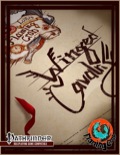
Letters from the Flaming Crab: Winged Cavalry (PFRPG) PDFFlaming Crab GamesOur Price: $2.99 Add to CartLeft me wanting more!Disclaimer: I received a free copy of this product. Letters From the Flaming Crab: Winged Cavalry is a 13-page supplement that delivers an alternate class for the cavalier – the Wind Warden. The Wind Warden, rather than inspiring and commanding allies, gains the services of a flying mount, and a host of abilities to help lessen the dangers of aerial combat. Abilities such as Order and Challenge remain unchanged from their Cavalier equivalent and will not be discussed here. First off the bat, the Wind Warden’s mount – which can be any Druid companion that has or gains the ability to fly - gains bonuses to Fly checks, the ability to fly in medium armour (but doesn’t automatically receive proficiency in it), and can carry the wind warden at normal speed. It can always take 10 on Fly checks, and gains three bonus feats from a restricted list over the course of advancement. As the Wind Warden levels, he can decrease falling damage, gain teamwork feats which his mount shares, and gain bonuses to attack rolls against flying targets. At the highest levels of play, he can use Trip combat maneuvers to knock flying enemies out of the sky, and even expend two uses of his Challenge to apply it to all flying enemies. The wind warden can choose from all orders available to cavaliers and samurai, but the pdf also presents five new cavalier orders that have the wind warden specifically in mind. Firstly, the Order of the Feather wind warden gains a Pegasus mount (complete with statistics for the companion), and is expected to patrol for the presence of evil creatures with her mount, taking action depending on the strength of their aura. Her challenge allows her to see her target through concealment, and as she progresses in level, she gains more and more bonuses against evil creatures – including extra damage, and leaving them shaken on a successful hit. Order of the Hunt wind wardens track and recover bounties with their pteranodon mounts, but unfortunately this order seems to lack something. The ability to track by scent more effectively is nifty, and dealing nonlethal damage with a lethal weapon is a bit plain, but what confuses me is the fact that the wind warden can add his Wisdom bonus to combat maneuver checks made against the target of his challenge. While it makes sense, I feel as though it doesn’t stand up to the eighth-level abilities offered by other orders, such as the Order of the Dragon’s strategy, or the Order of the Cockatrice’s steal glory. However, the final ability of the Order of the Hunt allows the mount to grapple as a free action when the wind warden hits the target of his challenge, which is very cool. Order of the Spire wind wardens, sworn to protect an object or place of great spiritual significance, receive perhaps the coolest mount among the new orders – magic carpets. In addition to this super cool construct mount (which can hover and, at 7th level, wield weapons in its tassels!), the Order of the Spire wind warden can charge from a distance up to four times his carpet’s speed, deal precision damage when attacking from above, and, at 15th level, gains spell resistance. The pdf also includes a statblock for magic carpets as a creature – a perfect thing to slip into a treasure hoard! The Order of the Sting presents a stealthy, giant wasp-riding, poisoning, criminal-oriented option. The Order of the Sting wind warden gains poison use, sneak attack – including an ability like pack flanking with his mount – and as a high-level ability, opponents poisoned by he or his mount are flat-footed against his attacks. The last order presented is the Order of Talon and Mane. Wind wardens belonging to this order take griffon mounts, swear to protect the weak and inspire those less fortunate than themselves, and gain abilities based around defending their allies- the feats Bodyguard and In Harm’s Way, with added effects, and granting the effects of Spirited Charge and Mighty Charge to their mounts. As added bonuses, the pdf then presents a chart of the most common checks made in aerial combat by both mount and rider, and a simple mechanic for cutting down on dice rolls from both parties. It closes with four new advanced aerial maneuvers – barrel roll, loop-de-loop, roll-off-the-top, and sudden dive. Letters from the Flaming Crab: Winged Cavalry is a well-formatted, visually clean product.It includes three pieces of art – a wind warden of the Order of the Spire, one of the Order of the Feather, and Captain Molly Shell of the eponymous Flaming Crab (tucked away near the OGL). The pdf includes a printer-friendly version without borders and backgrounds. In all, I found this to be an enjoyable read, and a must-have for mounted aerial combat (an underrepresented niche). From the new animal companions to the advanced maneuvers, this product delivers page after page of options that are mechanically sound, and just plain cool. I’ll clock it in at a solid four stars – the Order of the Hunt feels lacking, and I would have loved to see more maneuvers, maybe even suggestions for representing 3D combat on a 2D grid, but other than these quibbles, the product is worth the price of admission. Well done! 
The Tinker: Master of Modular Mechanical Mayhem (PFRPG) PDFInterjection GamesOur Price: $4.00 Add to CartA robot-deploying base classThe Tinker – Master of Modular Mechanical Mayhem is a complex, in-depth, customizable class with excellent potential. It is, however, something that should be attemoted by more experienced players, due to the large amount of options presented. The pdf weighs in at 34 pages, so let's crack it open and see what we have. The Tinker gets d8 hit dice, ¾ BAB, and 4+Int skill points per level. He also gets a good Reflex save, simple weapon proficiency, and proficiency with light armour and shields. As it turns out, medium and heavy armour interferes with ‘all of the ridiculous pantomiming’ that comes with issuing orders, creating a sort of mundane failure chance. Now for the crunchy class features, which the Tinker certainly brings in spades. Probably the biggest thing is the robots – or ‘automatons’, Small constructs with poor saves and a set number of hit points. The Tinker can deploy a number of automatons a day equal to his class level, and can have one out at a time at first level, eventually gaining the ability to have up to three automatons deployed at once. These automatons are built from blueprints, of which the Tinker only has a very limited number, which are customized with inventions (more on those later). The process takes an hour, much like a wizard preparing his spells. Once deployed, the Tinker has to give his automatons directives, which takes a standard action. The automatons, it should be reminded, have only a semblance of intelligence – the directives include warnings that, for example, should the target of an Attack directive die, the automaton will continue to maul the corpse. Automatons can also be directed to use potion injectors, repair kits, and any skills in which they have ranks as directives. Master’s Presence allows the Tinker’s automatons to use some of his own basic features, such as BAB and base saving throw modifiers, on their own rolls, while Scribe Invention functions much like Scribe Scroll, allowing the Tinker to make copies of his inventions to distribute – handy, as copying from one invention book to another tends to end messily! At every even-numbered level, the Tinker gains an Innovation, a breakthrough discovery that enhances his automatons. Such innovations include additional, specialized directives (such as Aid or Kamikaze), the ability to include design inventions in his blueprints without having to remove other inventions, heavier construction (granting automatons more hit points), more blueprints, self-defence programming, and, in a truly wonderful bit of flavour text, ‘Overzealous Execution’ – Having given each of your automatons a semblance of a personality, they suddenly begin to exhibit an almost dog-like desire to please you by following your commands with an overzealous excitement. Cute! Moving on, the Tinker gains ½ his class level as a bonus to Craft checks, and, at 4th level, the Alpha. The Alpha is a Medium construct, with an Intelligence score of 10 and the ability to gain feats. It can also hold more inventions, but the downside is that these inventions can’t be changed except upon gaining a new class level, or completely rebuilding the Alpha (an expensive process, but a necessary one if the Alpha falls). At 5th, 10th, and 15trh level, the Tinker gains a Greater Innovation. These allow him to, for example, grant extra hit dice to his automatons, decrease the cost of rebuilding his Alpha, change blueprints as a full-round action, and even make ‘gigadroids’ two size categories larger than normal. Probably the coolest ability, however, is the Swarm that the Tinker gets at 11th level – a swarm of nanobots that can duplicate fabricate to turn raw materials into a finished product, and, at higher levels, can process living creatures (as per disintegrate), and reshape solid magical effects. Finally, at 20th level, the Tinker has to choose a line of succession – the options are Constitutional Monarchy, Progenitor, and Gavelkind. As capstones go, I have to say this is a brilliant way of handling it – deciding what happens to your robot buddies after you die! We then get an overview of the automatons and the Alpha, complete with tables showing level advancement. Automatons gain a semblance of personality, as well as the ability to help, unasked, on Craft checks using the Aid Another action – a nice little mental image. The Alpha gains the ability to issue directives to other automatons, and to deploy automatons if the Tinker is unconscious or dead (though it can’t alter the blueprints). We then get some favoured class bonuses, a few feats (mostly focusing on Honorary Tinker, which allows a non-Tinker to issue directives to idling automatons or automatons defending them), and then 20 pages of Inventions, first grouped by level and summarized, then explained in full detail. There are too many to describe, so I’ll just say this much: many of them build off each other and you can find some fun combinations. And if you’re like me (easily overwhelmed by options), the author has helpfully included sample configurations at various levels, for various purposes. You can build a sunder-bot, a tripper, an electroshocker, a heavy melee bot, a missile blaster, or even a kamikaze root, built entirely to explode and deal as much damage as possible. Excellent stuff! Other inventions include potion injectors, crossbow turrets, and “robosaddles”, allowing the Tinker to saddle up his ‘bot and ride it into battle! The entire pdf is presented in crisp black and white, with a simple border and a few pieces of line art. If you’re looking for beautiful illustrations of the Tinker and his buddies, you won’t find them; however, you’ll probably be too busy trying to wrap your head around all the crunch. I’ll be honest, here – when I first read this class, I was overwhelmed. It definitely needs to be opened up and played with before you can begin to appreciate the true potential of the class. That said, I can’t recommend it enough. It’s a wonderful class, sprinkled liberally with humour, ridiculously customizable, and carrying plenty of support from the author. A solid five stars – worth every cent of the asking price! This pdf really lives up to its name - most of the feats within provide options that will make you wonder why they weren't in the game to begin with. For example, there's Exotic Hunter, which allows rangers access to the entire druid lost of animal companions. There are three feats offering new circumstances to use Vital Strike; Impressive Sneak Attack, which allows you to deal (non-multiplied) sneak attack damage on a critical hit; and Improved Combat Reflexes, which allows two additional attacks of opportunity per round (I know a few swashbucklers who'll appreciate that one!) I don't want to spoil too much more, so I'll leave it short, but this product is well worth it. Be warned, though - some of the feats are almost too good not to take. Such as Improved Furious Focus (Power Attack carries a penalty for a reason!) That said, there's more than enough awesome here to work well right off the bat, and some that may require adjudication. Look into it if you want more options! 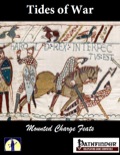
Tides of War: Mounted Charging Feats (PFRPG) PDFFlying Pincushion GamesOur Price: $0.99 Add to CartMore options for mounted chargesSince there isn't much content in this (as good as it is), there isn't a whole lot I can say without simply copy-pasting, but I'll try. Suffice to say that mounted characters have long felt shoehorned into using a lance - double damage on a charge, triple with the right feats - that's nothing to sneeze at. Tides of War: Mounted Charging Feats attempts to provide new options, and succeeds. It contains eight feats, in four mini-chains, each of which provides a unique ability to a particular weapon type when used during a mounted charge. Bleed damage, tripping, bull rushing, sickening - the benefits are simple but elegant, and as the second feat for each weapon required BAB +10, it retains its use in mid-to-high level games. Consider nabbing this for the party paladin or cavalier - or if you're the GM, watch the looks of horror on your party's faces when you start using new tricks against them! A solid product well worth the asking price, and deserving of five stars. In any large enough collection of archetypes, you're bound to find some you love, and some that just don't inspire you. So, that said, let's check them out! The Blood Scoundrel bloodrager gets an altered version of bloodrage that boosts dexterity, as well as an altered spell list, a delayed version of sneak attack, and the ability to select slayer talents in place of bloodline feats - an unusual combination, but it could work if that's what you're looking for. The Chakram Dervish fighter also has a cool suit of abilities focused around this unusual weapon, treating it as a light weapon when two-weapon fighting, throwing them without provoking attacks of opportunity, and make a full attack after moving - while I like this a lot, it unfortunately feels like most of its abilities come online too late to be particularly useful, which is a shame. Not so much for the Dread Thane skald, who gets all [fear] spells at the appropriate levels and a nifty suite of tricks to help him use them for maximum effect. The Edritch Sage magus gives up a lot of his combat ability for enhanced spellcasting. He can also activate a magic item and cast a spell in the same round with a variant of spell combat, increase his spell DCs using his arcane pool, and recall magic item charges. Not drastically different, but neat enough to consider. Then there's the Faithful Paragon warpriest - restricted to the lawful good alignment, and unfortunately wonky. For example, he can add his Wisdom modifier to his daily uses of fervour - however, fervour is already 1/2 level + Wis. He also gains the 'faith sustains' ability, allowing him to gain a bonus to constitution, with no mention of how often he can use it. Next up is the Grasslands Prowler ranger, who gets a unique combat style, a slightly expanded spell list, and eventually a variant of pounce. After him comes the katana duelist samurai, eschewing mounts and armour, gaining canny defense and the ability to parry and riposte - unfortunately, this seems to have the same problem as the chakram fighter in that it comes online relatively late. Not so much for the Mad Prophet oracle, wh can pronounce doom on her enemies (causing them to suffer penalties against her spells and revelations), and cause them to befall random calamitous events - such as tripping, loss of voice, random spellblights, and even mummy rot! Simple, but very cool. TheMyrmidon swashbuckler is basically 'swashbuckler with performance weapons', and not being a fan of performance combat, I'll leave her for someone else to talk about, because I'm more thrilled about the Nightmage rogue, who loses out on her talents, but gains ranger-progression arcane spellcasting of specific schools. Nifty! Then there's the Quickblade fighter, able to dash around the battlefield with ease, change directions while charging, and make all his attacks at various points during a charge - certainly compelling, and the thought of placing this on a naturally speedy enemy is terrifying. The Righteous Flame Acolyte paladin gives up Lay on Hands, replacing it with a flaming touch that she can use in addition to a full attack. She also gains resistance to cold, granting it to her allies in an aura effect. The Serenader bard can use charm person and dominate person through bardic performance, which, while neat, doesn't seem like enough of a niche to really carve. Then there's the Soldier of Gaia warpriest, who casts from the druid's spell list, spontaneously casts summon nature's ally spells, and can summon vines to attack as the black tentacles spell. Not bad! The Spellhound inquisitor gains spell combat and limited access to the magus spell list in exchange for her domain and judgement - not bad, but not terribly exciting. The Steel Valkyrie cleric, however, must take the War domain, gives up the other, and gains heavy armour proficiency. She also gets a deflection bonus to AC in heavy armour, an aura-effect bonus to Will saves, and eventually, the ability to fly on steel wings with no penalty! The Tavern Brawler is unfortunately another lacking archetype, gaining the ability to use her class features with improvised weapons, and in exchange, having her martial flexibility available only after a drink. The product powers on with the Warding Bastion cavalier, who threatens a wider area and makes it count as difficult terrain, grants half his shield bonus to allies, and can take damage for them. TheWar Genius investigator gets less skill points, better proficiencies, and gives up alchemy for the ability to mimic combat feats. Finally, closing out the product, we have the Wildfire Druid, who sees flame as a cleansing force - when she's not looking right through it, or ignoring her enemies' resistance to it as she spontaneously casts her domain spells - Fire domain, of course! There's plenty of great stuff in here - I'm personally fond of the Warding Bastion, Steel Valkyrie, and Mad Prophet, but everyone likes different things. Pick it up, and see what speaks to you! In a book of 21 archetypes, this bound to be some things you like, and some you don't. Rather than list everything here (though I'm happy to answer questions in the discussion), I'll just list wha I do and don't like here. I love the Avatar cleric, for one - she has additional restrictions on alignment, spells and weapons, but gains Deific Obedience as a bonus feat, and eventually gains a third domain. The Bomber rogue swaps sneak attack for bombs, and seems to be easily ported over to the ninja, for bonus sneaky demolitions. The Dashing Hero is a different take on a paladin, gaining panache and deeds, and the ability to dash across the battlefield, picking up an ally and carrying them out of harm's way! The Feytouched Hexer witch gains spontaneous, charisma-based spell casting and a list of fey-themed patron spells - I may be biased given my love of fey. The Monster Chronicler investigator gains favoured enemy (but can't select humanoids), and can change one of his enemies each day when he prepares his extracts - a cool niche that was missing from the game. The Spellscorn Fighter is probably one of my favourite archetypes within, a lean, mean, mage-killing machine who gains half his shield bonus to reflex saves, evasion, bonuses to ht and damage wants creatures that have used spells or spell-like abilities, and can eventually cut off a target from its magic! Then there's the Spirit-Scarred Paladin who can fly on phantom wings, the Weird Musician bard who gives up inspire courage to grant his allies eidolon evolutions, and the Witchknight inquisitor, who loses a domain but gains hexes and a familiar. Fantastic! The misses, for me, include the Gunmetal Mystic monk (not a fan of gun-fu, personally), the Gold-Robed Wizard (which lacks oomph), and the Divinely Bound Ranger (it gains a familiar, and... Not much else). All in all, I give this product a solid four stars. There's plenty in here that inspires me, and anyone reading is bound to find something they like as well. Disclaimer: I received a copy of this book in exchange for an honest and informative review. At $19.99 for the pdf, this book may have a high asking price, but if you run games that venture into dungeons from time to time, it will be worth it. Just take a look at the product description, and see what you're getting here. Now consider this: every one of those headings, from doors to ceilings to trap doors to walls, has more information than you can shake a stick at. All the handy bits of information you may not be able to keep in your head (such as break DCs, hardness, and the DC of acrobatics checks to jump on an altar), two tables of dressing and features, and traps. Glorious, glorious traps! Crushing ceiling trap? It's here. Illusory sarcophagus trap? Yep, that's here too. A portcullis with a banshee bound inside it? You better believe it's here! Ever wanted to know what the goblin had in his pockets? Players asking what the ceiling looks like? Considering foreshadowing a trap or hazard with a doom panting? Looking for some prisoners to throw in, ready to be rescued? How about enough riddles to outwit a sphinx? Or some legends for the loose-lipped barkeep to tell, which may or may not be true? If you're feeling particularly creative, you may even find plot hooks - exactly why did the dungeon owner purchase this painting for over ten times its value? All this glorious goodness is sandwiched between a chapter on dungeon design, and over two hundred treasure hoards of 1st to 20th level. These hoards are a real gem, too - full of quirky items, such as thousands of silver coins stored in woolen socks; an entire galley; a stool made of scrimshawed wyvern bones; even a gilded iron maiden - as well as enough jewellery and gems and coins to choke a dragon! If you're a GM, pick this up. If you're a player, pick this up for your GM. It'll be well worth it! Not only does this product offer twelve new orders, each comes equipped with one or more feats (available to anyone meeting the prerequisites, and available as bonus feats to particular orders), as well as a piece of artwork depicting a cavalier of the order, his mount (with the exception of the Orders of Fortune and the Sea), and his heraldry! What more could you want? Since this product has been reviewed in depth below, I'll summarize the orders presented within: Black Rose: Undead-commanding slayer of positive energy channellers.
Some of the orders feel a bit lacking to me - in particular, Scorpion and Truth seem to be lacking in 'oomph', and Sea is too situational to see much use outside of a nautical campaign. However, there are plenty of great orders here as well (I love Fortune, Luck, White Rose, and Claymore!), and the feats give it just the extra push it needs. As a final bonus, the Dual-Sworn Knight archetype gives up a mount, but gains a second order (with delayed abilities) and extra-deadly charges. The archetype can even be applied to the samurai, as well! This has to be one of my favourite third-party products to date - killer content, great art, and more goodies than you can shake a stick at. Whether you love cavaliers, or have been looking to play one but hadn't found the right special something, pick this up! 
Bosco's Spell Compendium: Cantrips and Orisons (PFRPG) PDFFlaming Crab GamesOur Price: FREE Add to CartFun and free - what are you waiting for?This product is 10 pages long, of which 5 are devoted to the cantrips and orisons in question - and lordy, what spells they are! After a brief suggestion on how to use these spells in your game, we get groupings of the spells by class (always a nice gesture), then the spells themselves. Since this is free and you should pick it up anyway, I'll just try to lure you in by saying that the presentation is hilarious, sprinkled liberally with descriptions sure to make you chuckle. It's an enabler of shenanigans, perfect for those who don't take their worlds too seriously, and again - you can't go wrong with a price of 'free'. What are you waiting for? Download this now! Into the Breach: The Cavalier has 26 pages of content, and manages to pack in a surprising amount of awesome options for these mounted warriors. From the 11 archetypes to the new magic weapon property, you're bound to find something worthwhile. If that's not convincing enough, read on for a few more details! The book opens up with 11 new archetypes, and the Airborne Knight immediately sets the 'rule of cool' bar high. Ever wanted to play a cavalier with a flying mount - at 1st level? If you're happy to give up the Tactician abilities, you can take your pick of griffon, wyvern, giant wasp, or four more options! It continues strong with the Briar Knight, who doesn't get a mount, but a plant companion that he can wear as armour. At higher levels, he gains the ability to trip opponents with his vines, root himself to the ground, heal and sustain himself through photosynthesis, and more! Can I break the review tone for a moment to stress how much I adore this archetype? Unfortunately, the Charioteer doesn't inspire new ideas for me like the others. He begins play with a horse and chariot, which he can replace at any time without penalty, and gains a new driving stunt at every level, the ability to quickly repair his chariot, and the ability to ram other vehicles without falling prone. Admittedly, I'm ambivalent to this one as I've never read nor used the vehicle rules - perhaps with more knowledge and the right campaign, I could say a lot more about it. The Clockwork Knight doesn't get a mount until fourth level, at which point he builds his own mechanical companion and can upgrade it at higher levels, increasing its size, granting it intelligence, integrating a crossbow, or more - perfect for a steampunk game, or an Alkenstar marshal. Available only to evil cavaliers, the Crudus Domitor gains thematic templates for his mount, and a cool suite of abilities based around terrifying his enemies and chasing them down when they try to flee. The Formation Rider seems a bit of an NPC archetype, being based around mounted charging as a group, but may see some use in Lastwall, or possibly a Wrath of the Righteous or Kingmaker campaign. The Lord in Burlap is a super-fun archetype based around the call of the common folk. Fighting alongside farm animals, wielding farming equipment as improvised weapons without penalty, disarming opponents and sticking their weapons in the ground - the peasants are revolting, and it looks like fun! On the flip-side, the Mounted Brigand will fit right in with your Kingmaker campaign, gaining, among other things, the ability to apply his own stealth checks to his mount, sneak attack, and a brilliant variant on his order that needs to be read - its not very often a class feature makes me laugh out loud, but this one did. Kudos to the designer! Onward to the Oath-Bound Protector, who devotes himself to protecting a specific ward, granting them bonuses based on his order when he issues a challenge, and gaming the ability carry them on his mount without penalty. The female-only Shieldmaiden doesn't gain a mount, but acquires several nifty shield-based abilities, such as countering missed melee attacks with a shield bash, using the shield as her banner, and applying its bonus to her saves as well as her AC. Next up, the Spirit Rider, who gains an ethereal mount that takes up no space (handy for you dungeon-crawlers!), and a bonded spiritual weapon which he can enhance with special abilities. The last archetype is the Steadfast Defender, made to cut across the battlefield quickly and take down an enemy leader, able to move at full speed in medium or heavy armour, apply these bonuses to his mount, and make attacks of opportunity against those moving into his threatened area. The alternate class presented is the Sword-Sworn Troubadour. I'm going to be honest here: I want to like this. I really do. But his battle hymns take a full round to activate, have a short duration, and he gains a total of five combat feats with no way to share them. Cool as an NPC class, or a cohort, but a bit boring for a PC. The prestige classes presented each cover a different theme, starting with the Fey Warden, who can progress divine spellcasting, reduce his size as reduce person, and grow wings. He also gains a new order, the ability to use wild empathy on fey, and can speak to plants or animals at will. Another cavalier/divine casting prestige class, the Obsidian Knight, can weigh down enemies wearing metal armour, call forth walls of earth and stone, and rupture the earth to bull rush enemies at a distance! The Rime Rider seems to be made for Irrisen, requiring a cavalier's order and the boreal sorcerer bloodline. I'm going to break my tone again here to point out that they can have a large-sized polar bear mount and adamantine ice weapons. The PDF closes out with the Order of the Bow, based around mounted archery; the pummeling weapon and shield property; and a handful of mundane items like the jousting lance tip and standing saddle stirrups. I'm not going to lie - I'm thrilled that this product exists. Cavaliers are one of my personal favorite classes, and Into the Breach: The Cavalier gives them a slew of new toys to play with. Flying mounts? Symbiotic armour? Less-than-honorable riders? All magnificent bits of design. There's a lot in here I can't wait to play with, and while some of it strikes me as lacking, it's an overall solid product well worth the asking price. Four out of five stars, and I'll be using plenty! Spellstaff: The Magic User's Weapon aims to provide a thematic weapon for magic users, such as wizards, allowing them to continue contributing in combat between spells or after expending their available slots. This is accomplished through the eponymous Spellstaff - at its base, a ranged weapon that uses charges as ammunition. Magic users recharge their own spellstaves without the need to expend spell slots, and a prepared caster can even do this as part of their preparation ritual. A variety of spellstaves are then listed, from the basic attuned spellstaff (which changes the weapon's damage type) to the spellstaff of the mechanical genius, which can ignore cover and concealment! I also have to mention my favorite, the secret spellstaff, which can be disguised as an ordinary cane. Next up, we get six new traits, including the flavorful Great and Powerful, which allows you to count as one size larger when making intimidate checks with your spellstaff in hand. Fifteen feats follow, allowing you to use your spellstaff to enhance spells with metamagic, recharge wands, or trigger primal magic events. The product also contains several archetypes, the first of which is the Spellstaff Witch, who bonds her snake familiar with her spellstaff. The Spellstaff Adept wizard gains extra feats and utility with the spellstaff at the cost of magical versatility. The Spellstaff Channeler sorcerer can overcharge her spellstaff for extra damage, as well as string together a chain of missiles, while the Spellstaff Dancer bard can take 10 on Perform (dance) checks, gains a dodge bonus to AC similar to canny defense, and gains several new performances such as evasion dance and fire breath finish. The Spellstaff Disciple fighter sacrifices weapon and armour training for the ability to lower arcane failure chance, and cast a (very) small number of arcane spells, using charges from a spell staff to power them - a great way to represent a character who dabbles! The Spellstaff Healer cleric gains only one domain, which must be the Healing domain, but is she ever good at it! Expending charges to deliver healing spells at range, empowered healing spells, and an effective increase to caster level if she hasn't harmed an enemy during a given combat - very cool! The Spellstaff Scrapper brawler can recharge her Spellstaff by confirming critical hits or dropping an enemy below 0hp, as well as manifest solid energy weapons on the end of the weapon, each providing a different set of properties and bonus feats. Awesome! Fans of Flaming Crab Games' own base class, the Priest, will be glad to see the Spellstaff Shepherd archetype, who gains several neat and thematic abilities centred around locating and protecting their 'flock'. Also provided to close out the product is a sidebar on incorporating Spellstaves into an existing world; several plot hooks revolving around the weapons; and even an FAQ! All in all, this is a cool product, providing not only a new weapon but a truly staggering amount of support for it. If you want to play a magic-user with a more thematic weapon than a crossbow, or a nonmagical character able to enhance a staff in a new way, pick it up - you won't be disappointed! |
|





